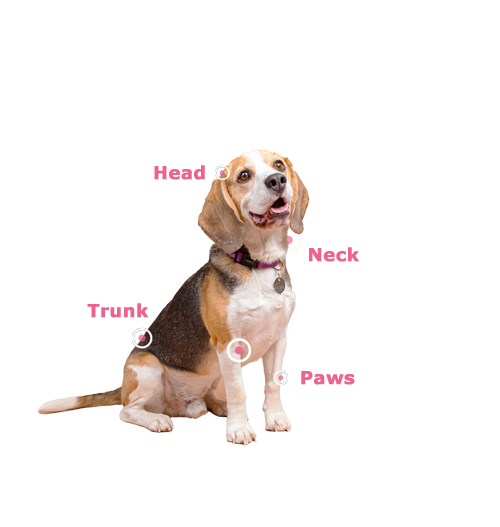
Skin Tumours
Early detection of skin cancer is in your hands.
Make the most of your contact time with your faithful friend. Whether it be sharing the sofa or during the grooming routine.
Every moment you share you can be helping them.
By feeling for possible lumps and bumps you can help identify any concerns quickly.
A frequent skin check can also help you detect any other issues, such as fleas, ticks, and other skin conditions.
If you notice any lump or bump, see your vet.
Your dogs skin can change over the years. When a lump appears on the skin, we are usually concerned, but it does not always mean cancer.
Common lumps and bumps in dogs include:
- Mast cell tumours
- Fatty tumours
- Sebaceous cysts
- Warts
- Abscess
When a lump appears it is important to go to the vet as soon as possible, since the early detection of skin cancer improves the outcome.
Some of the more common types of skin cancer in dogs are:
- Mast cell tumours
- Malignant melanoma
- Squamous cell carcinoma
- Histiocytic cell tumors
- Fibrosarcoma
Mast cell tumours are highly variable in their appearance, but the classic mast cell tumour is going to be hairless, raised and pink to reddish, and they can shrink and grow over a short space of time. It’s really important to evaluate any new lump or bump since 1 in 5 lumps could be a mast cell tumour.
Some factors can affect the risk of canine mast cell tumour, like genetic mutations, age, breed, or chronic inflammation.
Mast cell tumours are primarily a disease of older dogs but have been reported in younger dogs.
Some breeds are
more susceptible to mast cell tumours, including:

BOXER
![]()
ENGLISH BULLDOG
![]()
LABRADOR RETRIEVER

COCKER SPANIEL
![]()
BOSTON TERRIER
![]()
WEIMARANER
![]()
GOLDEN RETRIEVER

SCHNAUZER
![]()
FRENCH BULLDOG
![]()
BEAGLE
![]()
STAFFORDSHIRE BULL TERRIER
![]()
PUG
Shoop et al.: Prevalence and risk factors for mast cell tumours in dogs in England. Canine Genetics and Epidemiology 2015 2:1.
About 50% to 60% of mast cell tumours are on the trunk of the dog.
Other common locations are the paws, head or neck.

Initially, a lump should be evaluated with fine needle aspiration (FNA) and a microscopic examination of the sample. This can help the vet determine if there are tumour cells present or not.
Fine needle aspiration benefits are:
Simple and fast diagnostic test
Minimally invasive
Relatively low cost procedure
Usually it can be done without sedation
